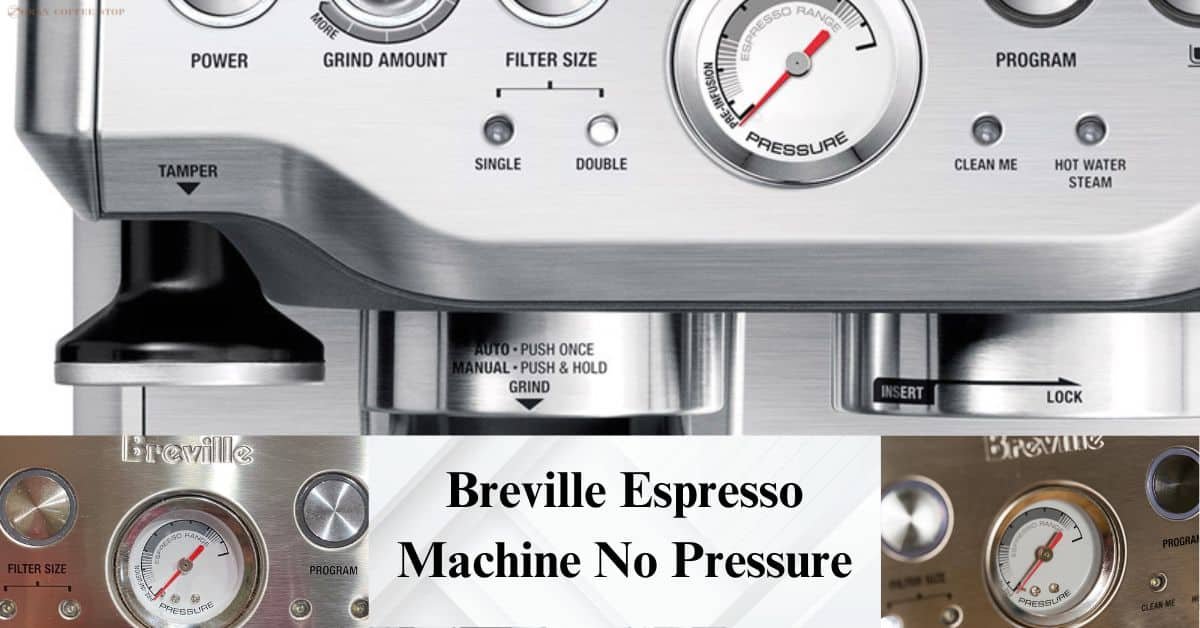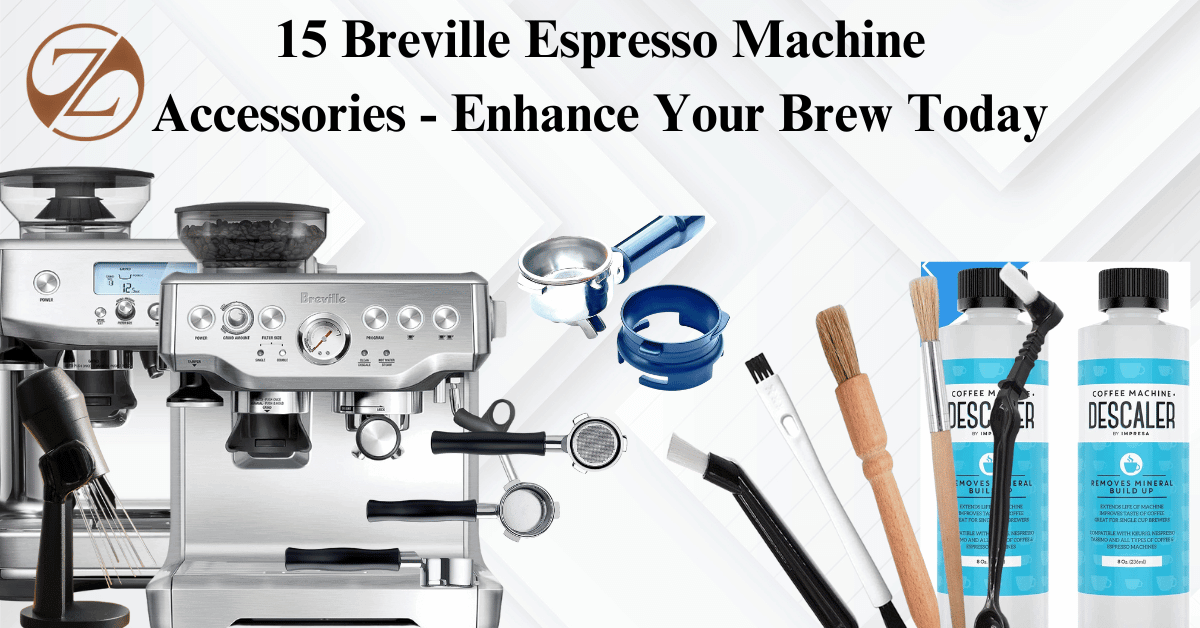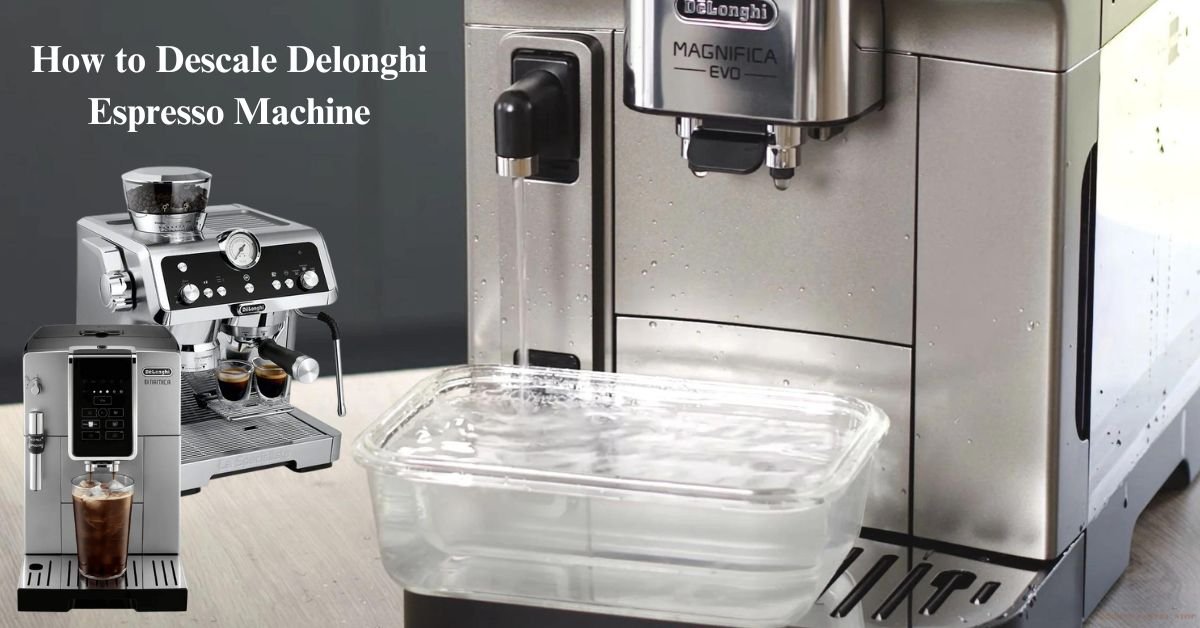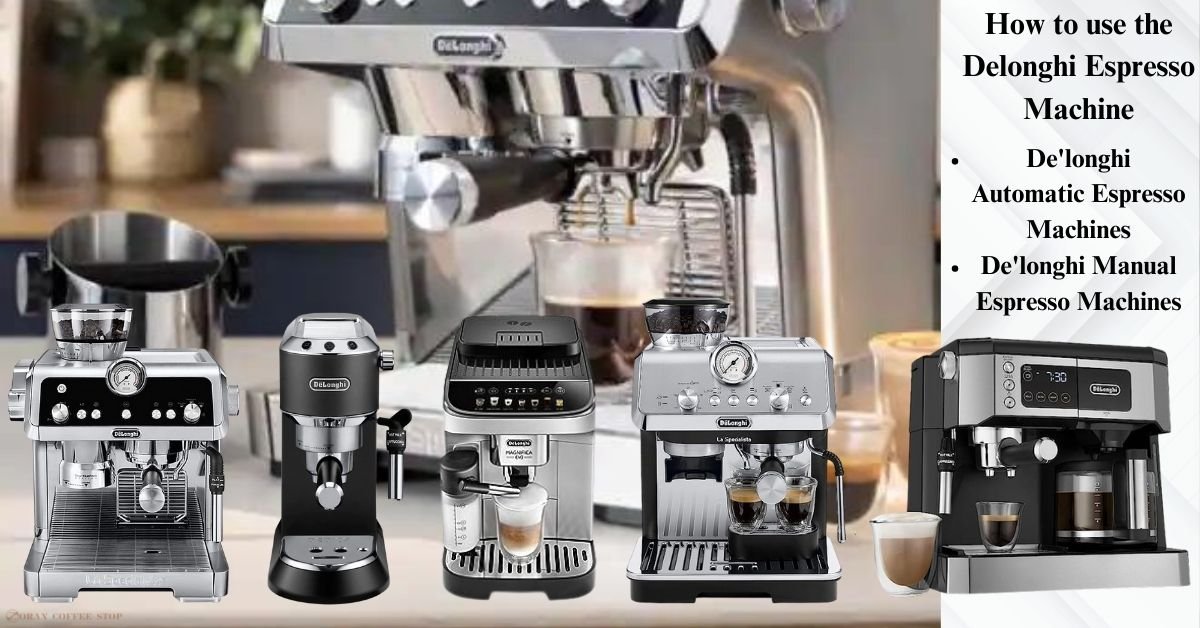As all coffee lovers know, Espresso is a coffee drink made by forcing hot water through finely-ground coffee beans under pressure. The pressure is essential for creating the rich, crema-topped flavor that we associate with espresso. If your Breville espresso machine is not reaching pressure, it will not be able to make that perfect cup of espresso.
There are many things that can cause low pressure in a Breville espresso machine. Some of the most common problems include using coffee beans that are ground too coarse, not putting enough coffee in the portafilter, not tamping the coffee grounds firmly enough, leaving leftover coffee gunk in the machine, a faulty rubber seal or gasket in the pressure gauge, and using old, expired coffee beans.
In this article, we will take a closer look at each of these problems and give you easy fixes you can do at home. We will also provide some tips for preventing low pressure in the future. So, if you are facing any issues with your Breville Espresso Machine no Pressure, don’t worry! There is a good chance that you can fix it yourself with a few simple steps.
Importance of Pressure In Espresso
The ideal pressure for espresso is 9 bars. It’s like water being pushed through coffee grounds with the force of nine times the pressure we usually feel around us. If the pressure is too low, the espresso will be weak and watery. If the pressure is too high, the espresso will be bitter and over-extracted. The pressure ensures that the water is evenly distributed throughout the coffee grounds, which results in a more consistent extraction.
Pressure helps to create a richer, fuller-bodied flavor in espresso by extracting more of the flavor compounds from the coffee beans. This is why espresso is often described as having a “bold” or “intense” flavor. Pressure also helps to prevent channeling, a problem that occurs when the water flows through only a small part of the coffee grounds, resulting in a weak or uneven extraction.
Additionally, pressure helps to create crema, the foamy layer that forms on top of the espresso. Crema is made up of tiny bubbles of carbon dioxide and coffee oils, and it gives espresso its characteristic look and taste.
Common Signs of Low Pressure
| Signs of Low Espresso Pressure | Possible Meaning |
|---|---|
| Weak & Watery Espresso | Insufficient pressure for flavor extraction |
| No Crema | Pressure is not high enough for bubble-rich crema |
| Channels in Coffee | The pressure is not high enough to evenly distribute the water. |
| Bitter Taste or Over-extracted Espresso | Pressure too high or coffee grounds too fine |
| Loud Machine Noise | Machine straining to force water through the coffee grounds. |
| Slow-Motion Espresso | Low-pressure hampers flavor extraction |
| Quick “Short Shot” | Fast shot, lack of depth suggests low pressure |
| Reduced Aroma | Low pressure makes flavor extraction difficult |
| Thin Crema Rings | Inconsistent crema rings suggest low pressure |
Why is my Breville Espresso Machine not Reaching the Pressure
When your espresso machine doesn’t make strong coffee, there could be a few reasons. It might be because the coffee grounds are too coarse, you didn’t use enough coffee, the beans are old, the machine is clogged, or the pressure gauge is broken. Let’s figure out the reason together and get your espresso back to its delicious flavor!
The Ideal Grind Size Matters
The grind size is one of the most important factors in making espresso. The grind size determines how much surface area the coffee grounds have, which affects how quickly the water can flow through them and how much flavor is extracted.
For espresso, the ideal grind size is a medium-coarse grind, slightly coarser than table salt. If the grind is too coarse, the water will not be able to flow through the coffee grounds quickly enough, resulting in low pressure. If the grind is too fine, the water will not be able to flow through the coffee grounds at all, resulting in a bitter and over-extracted espresso.
When it comes to espresso, grind size is a silent operator of pressure control. Here’s how it works:
Finely ground coffee can lead to higher pressure. The water struggles to pass through, causing a traffic jam and increasing the pressure. While this might sound good, it can over-extract flavors, resulting in bitterness.
A coarser grind means water passes through quickly. The pressure might not build up enough, leading to weak extraction and a watery espresso.
Inconsistent grinds can cause uneven pressure, which will have an impact on extraction. Invest in a quality burr grinder for more control. If your espresso is coming out too slow and strong, try a slightly coarser grind. If your espresso is coming out too fast and weak, go a bit finer.
Coffee Quantity Can Effect Breville Espresso Pressure
The coffee quantity is another important factor in making espresso. The coffee quantity determines how much resistance the water has to flow through the coffee grounds, which affects how much pressure is built up.
For espresso, the ideal coffee quantity is 18-20 grams for a double shot. If you use too little coffee, the water will not have enough resistance to build up pressure. If you use too much coffee, the water will not be able to flow through the coffee grounds quickly enough, resulting in low pressure.
How to Make a Perfect Espresso
Here’s how it works:
Using too few coffee grounds means there’s less resistance to the water. It flows too quickly, leading to weak pressure and a diluted espresso.
Overloading the portafilter with coffee grounds can choke the water flow, causing high pressure and a slow, bitter extraction.
To ensure consistent extraction, level your coffee grounds evenly in the portafilter. By doing this, uneven pressure is avoided and it is ensured that every component of the coffee has a chance to shine. If your espresso is coming out too slow and strong, try using a bit less coffee. If your espresso is coming out too fast and weak, try using a bit more coffee.
Breville Espresso Machine no Pressure (Tamping Matters)
Tamping is the process of pressing the coffee grounds into the portafilter. Tamping is important because it helps to create a consistent puck of coffee that will allow the water to flow through evenly.
For espresso, the ideal tamping pressure is 30 pounds per square inch. If you tamp too lightly, the puck will be too loose and the water will not be able to flow through evenly, resulting in low pressure. If you tamp too hard, the puck will be too dense and the water will not be able to flow through at all, resulting in a slow and strong espresso.
To tamp espresso grounds properly, you will need a good-quality tamper. A good tamper will have a flat surface and a comfortable handle. You will also need to use a steady tamping motion and apply even pressure throughout the tamping process.
Here are the steps on how to tamp espresso grounds
- Place the portafilter on a level surface.
- Spread the coffee grounds evenly in the portafilter.
- Tamp the coffee grounds until they are level and firm.
- Experiment with different tamping pressures to find what works best for you.
Additional things to keep in mind about tamping
- Tamping too hard can create channeling, which is when water flows through the coffee grounds in uneven channels. This can lead to uneven extraction and bitter espresso.
- Tamping too lightly can also lead to uneven extraction, as the water will not be able to flow through the coffee grounds evenly.
- The grind size also affects the amount of pressure needed to tamp. A finer grind will require more pressure to tamp evenly, while a coarser grind will require less pressure.
- The type of coffee beans also affects the amount of pressure needed to tamp. Espresso beans are typically roasted darker than other types of beans, and they will require more pressure to tamp evenly.
Hidden Coffee Residue
Hidden residue can build up over time and can affect the taste of the espresso, as well as the pressure that can be built up. There are a few things that can cause the lurking coffee residue to build up like;
- Using stale or old coffee beans
- Not cleaning the espresso machine regularly.
- Using too much coffee or tamping too hard can also contribute to the buildup of residue.
Impact on Espresso Pressure
It can affect the pressure of the espresso in a few ways. First, it can create a barrier that prevents the water from flowing through the coffee grounds evenly. This can lead to uneven extraction and bitter or sour espresso. Second, the residue can clog the portafilter and group head, making it difficult for the water to flow through at all. This can result in a weak and watery espresso. Moreover, Cracks and crevices with residue can cause pressure leaks, weakening the overall brewing process.
Effective Cleaning Techniques
Keeping your machine free from coffee residue requires regular maintenance:
- After each use, rinse the portafilter and baskets under hot water to prevent immediate buildup.
- Use a blind filter basket to run backflush cycles with water and cleaning agents to remove residue from the group head.
- Remove group headscreens and clean them with a brush and cleaning solution. Scrub stubborn residue with a soft brush or toothbrush.
- Perform a thorough cleaning by dismantling and cleaning the portafilter, baskets, and group head components on a monthly basis.
- Empty and clean your grinder’s hopper and burrs to prevent oily buildup from affecting grind consistency. A dirty grinder can affect grind size so clean it before adjusting the grind settings.
You can also read out more detailed guide about;
How to Clean a Breville Espresso Machine Daily 4 Steps & Deep Clean Guide
Flush your machine with hot water before and after brewing to clear any residual oils. Use filtered water to reduce mineral buildup that can contribute to the residue.
The seal or Gasket is Broken
Seals and gaskets are like the protective barriers of your espresso machine. A seal or gasket is a rubber or silicone component that creates a tight seal between two parts of an espresso machine. This is important to prevent leaks and ensure that the machine can reach the proper pressure. If a seal or gasket is broken, it will no longer create a tight seal. This can cause water to leak out of the machine, which will reduce the pressure.
| How to Diagnose | How to Replace |
|---|---|
| Check for leaks. Look for any signs of water leaking from the machine, such as water droplets on the sides or bottom of the machine. | Carefully remove the old, damaged seal or gasket from its location. |
| Inspect the seals and gaskets. Remove the portafilter and group head from the machine and inspect the seals and gaskets for any signs of damage, such as cracks, tears, or hardening. | Use a damp cloth to clean the area around where the new seal or gasket will be installed. This ensures a clean and secure fit. |
| Keep an eye out for fluctuations in pressure during the brewing process. Inconsistent pressure levels can also be indicative of problems with the seals or gaskets. | Apply a thin layer of lubricant to the new seal or gasket. This helps ensure proper sealing and ease of installation. |
| If the water takes longer than usual to pass through the coffee grounds, faulty seals or gaskets might be to blame for the slower flow. | Install the new seal or gasket correctly in its designated location. Ensure it is aligned and fitted snugly. Tight any screws or nuts that are meant to hold the seal or gasket in place. |
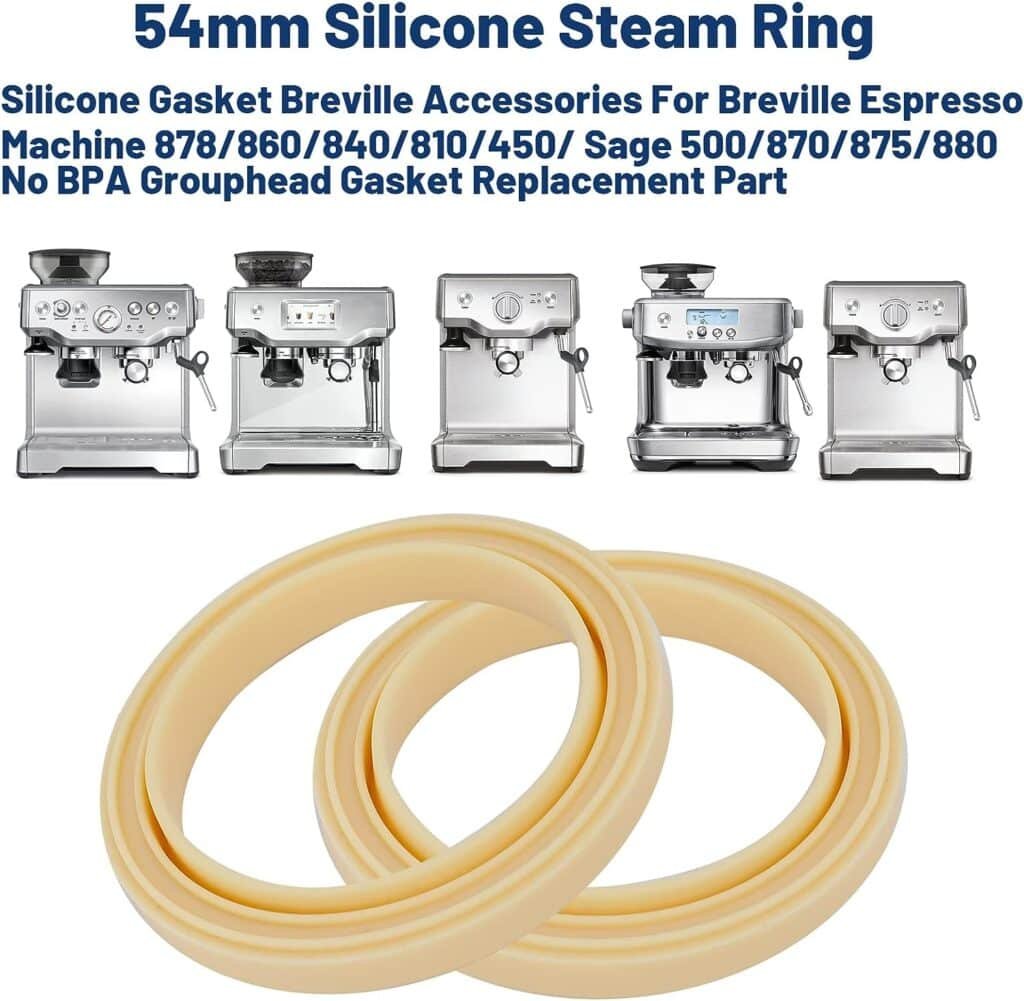
54mm Silicone Steam Ring, Silicone Gasket For Breville Espresso Machine.
- The 54mm Silicone Steam Ring serves as an effective replacement for worn-out seals and gaskets in Breville espresso machines. It addresses issues related to pressure loss, ensuring a secure fit that prevents moisture leaks during brewing.
- Crafted from high-quality silicone, this steam ring offers enhanced durability and heat resistance, outlasting ordinary rubber gaskets. Its longevity helps maintain consistent pressure and flavor extraction over time.
- With compatibility for various Breville espresso machines and a temperature range of -65°F / 54°C up to 450°F / 230°C, this steam ring proves essential for maintaining a well-functioning espresso setup.
After trying the 54mm Silicone Steam Ring, I can confidently say it’s a game-changer. The durable silicone material provides a perfect fit, preventing steam leaks and ensuring consistent pressure. Remember, even seemingly complex problems can have simple solutions. Always check your machine’s collar and ensure it’s firmly attached. Additionally, tighten any loose screws and make sure the seal is fitted snugly.
How to Keep Your Espresso Machine’s Seals and Gaskets in Good Condition
To keep your espresso machine’s seals and gaskets in good condition, you should have to Descale your machine regularly. This will help remove limescale buildup, which can damage the seals and gaskets. You can use a descaling solution designed for espresso machines, or you can make your own by mixing equal parts of white vinegar and water.
Always use filtered or bottled water as it will help to reduce the amount of minerals in the water, which can also damage the seals and gaskets. Moreover, Clean your machine after each use this will help prevent the build-up of coffee oils and residue, which can also damage the seals and gaskets To clean your machine, you can use a mild detergent and water. Be sure to rinse the machine thoroughly after cleaning.
When replacing seals or gaskets, make sure they are installed correctly. Always Use original equipment manufacturer (OEM) parts when replacing seals or gaskets. OEM parts are made to the exact specifications of your machine, so they will create a better seal and last longer. If you are not comfortable replacing the seals and gaskets yourself, you can always take your espresso machine to a qualified technician.
The Age of Coffee Beans
Just like fruits, coffee beans have a special time when they taste their best. Fresh beans are full of flavor and make strong pressure for good espresso. As beans get older, they lose moisture and oils, which changes how they taste and how much pressure they create. When you make espresso, the water is forced through the coffee grounds at high pressure. This pressure helps to extract the flavor from the coffee beans.
Check out some top coffee beans for making a good shot of espresso;
Lavazza Espresso Italiano Whole Bean Coffee Blend, Medium Roast
Lavazza Super Crema Whole Bean Coffee Blend, light-Medium Espresso Roast
Extraction is the process of pulling the flavor out of the coffee beans. When the beans are fresh, they are more porous and allow the water to flow through them more easily. This results in a more evenly extracted espresso. Older beans are less porous and do not allow water to flow through them as easily. This can result in an unevenly extracted espresso, with some parts of the shot being more flavorful than others.
Older beans may not be able to withstand the pressure of the espresso machine as well as fresh beans. This can cause the machine to not reach the desired pressure, resulting in a weak or watery espresso. If your Breville espresso machine is not reaching pressure, it could be due to the age of the coffee beans. If you are using stale beans, try using fresher beans and see if that makes a difference. You can also try adjusting the grind size or tamping the pressure.
| Signs of Aged Beans | Maximizing Bean Freshness |
|---|---|
| If the beans lack the vibrant aroma you’re accustomed to, they might be losing their freshness. | Choose beans with a recent roast date to ensure maximum freshness. The best beans to use for espresso are roasted within the last 1-2 weeks. |
| A flat or lackluster taste suggests that the beans have lost their optimal flavor. | Store whole beans in an airtight container away from light, moisture, and heat to preserve their freshness. Coffee beans should be stored in a cool, dark place, such as a pantry or cupboard. |
| Beans that are starting to lose their moisture will become baggy or hard. | Pre-ground coffee ages faster due to increased surface area exposure. Grind only what you need just before brewing. |
| Brown spots on the beans are a sign of oxidation, which can also affect the taste and pressure. |
Beans are best a few weeks after roasting. They’re very flavorful and make great espresso. After a few weeks, flavors and pressure change a bit. After some months, beans get older, so pressure and flavor aren’t as good. They’re still okay to drink, but not as amazing as before. |
For the best espresso experience, remember to grind your beans right before making coffee. This keeps the flavors fresh. Use a burr grinder to make sure the coffee grounds are always the same size, giving you even extraction. Also, make sure to clean your espresso machine often to prevent any problems. Moreover, when you’re not using your machine, keep it in a cool and dark place.
Breville Espresso Machine Pressure Gauge not Working
The pressure gauge is like a special window that shows how strong the brewing pressure is. It tells you how hard the water pushes through the coffee. The pump is the machine’s water mover. It pushes the water through the coffee grounds and decides how strong the pressure becomes.
| Signs of Pressure Gauge or Pump Problems | Troubleshooting Steps |
|---|---|
| If the pressure gauge needle bounces around or stays stuck at one point, it might mean the pump or gauge has issues. | Make sure the gauge is set up correctly as per the manufacturer’s instructions. |
| If the gauge always shows low pressure or there’s hardly any pressure during brewing, the pump might not be working well. | If the pressure is always low or doesn’t show up, the pump might be the problem. |
| Weird sounds while brewing, like loud knocks or clanks, could mean the pump is acting up. | Watch how the pump works – if it acts strange, leaks, or makes odd noises, it could be having problems. |
| If the gauge needle moves a lot without changing the taste of your coffee or how long it takes to brew, then the gauge might be the issue. | If the readings are still strange, think about getting a new gauge that matches your machine. |
Breville support
If you continue to encounter challenges with your Breville espresso machine despite the insights provided in this guide, don’t hesitate to seek further assistance. Breville’s dedicated support team is ready to help address your concerns. You can easily reach out for assistance by visiting their Support page, Chat with Support Agent, or by phone at 866-273-8455.
Some additional tips for troubleshooting
- Check the water supply to make sure it is turned on and there are no leaks.
- Make sure the portafilter is properly inserted into the group head.
- Prime the pump by running water through the machine without coffee grounds.
- Descale the machine if it has not been descaled in a while.
Conclusion
In conclusion, there are many things that can cause low pressure in a Breville espresso machine. The most common causes are using the wrong grind size, tamping too hard or too lightly, using stale coffee beans, or having a clogged portafilter or broken gasket. If your espresso machine is not reaching pressure, you can try troubleshooting step by step using the details in the above comprehensive guide.
To prevent low pressure in the future, it is important to use fresh coffee beans, grind the beans to the correct size, tamp the coffee grounds evenly, and clean the espresso machine regularly. You should also check the pressure gauge and gaskets regularly to make sure they are in good condition.
Why is my espresso machine not pushing out espresso?
If your espresso machine is not pushing out espresso, it’s likely due to low pressure caused by various factors. The grind size of your coffee beans might be too coarse or fine, affecting the water’s ability to flow through and create pressure. Additionally, improper tamping of the coffee grounds or using the wrong quantity of coffee can lead to inadequate resistance and pressure buildup. Hidden coffee residue and a faulty seal or gasket can also impact pressure.
What pressure do Breville espresso machines use?
Breville espresso machines typically use a brewing pressure of around 9 bars, which is considered the ideal pressure for extracting espresso. This pressure level helps ensure that the water flows through the coffee grounds evenly, extracting the optimal flavors and creating the characteristic crema on top of the espresso.
How do I get more pressure out of my espresso machine?
If your pressure gauge reads below 8.5 while extracting espresso, it’s likely due to water passing through the coffee grounds too quickly, resulting in a weak, sour taste. Try these fixes:
Ensure your machine’s collar is firmly attached; a loose collar can affect pressure.
Damaged seals may lead to pressure issues; check and replace if needed.
Adjust your grinder to a finer setting to slow down water flow.
Aged beans may not provide optimal pressure; go for recently roasted beans.
Increase the coffee dosage in the portafilter for better extraction.
Apply more pressure when tamping to enhance resistance.
Residue buildup can impact pressure; clean your machine consistently.
